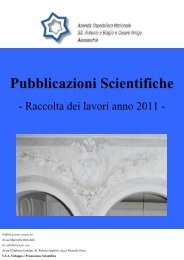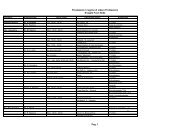Working Paper of Public Health Volume 2012 - Azienda Ospedaliera ...
Working Paper of Public Health Volume 2012 - Azienda Ospedaliera ...
Working Paper of Public Health Volume 2012 - Azienda Ospedaliera ...
You also want an ePaper? Increase the reach of your titles
YUMPU automatically turns print PDFs into web optimized ePapers that Google loves.
<strong>Azienda</strong> <strong>Ospedaliera</strong> Nazionale“SS. Antonio e Biagio e Cesare Arrigo”<strong>Working</strong> <strong>Paper</strong> <strong>of</strong> <strong>Public</strong> <strong>Health</strong>nr. 10/<strong>2012</strong>nerves. The centre <strong>of</strong> the cough is located close to the breath centre, in the medulla oblongata. Theefferent pathways are represented mainly by the inferior laryngeal nerve (glottis), the phrenicnerve (diaphragm) and spinal nerves (intercostals and abdominal muscles). The cough is the finalphase <strong>of</strong> a reflex that can be divided in four stages: irritation, inspiration, compression and ejection(Table 2):1. Irritation: stimulation <strong>of</strong> cough receptors placed in laryngo-tracheal and in bronchial tree.2. Inspiration: it must be rapid and deep to facilitate the return <strong>of</strong> elastic lung parenchyma,with the aim <strong>of</strong> producing the maximum expiratory flow possible. High lung volumeoptimizes the voltage-length <strong>of</strong> the expiratory muscles, allowing to generate high pressuresand high expiratory flow. During this phase, the glottis is open thanks to the abductormuscles <strong>of</strong> the cartilages aritenoidee. This allows the divergence <strong>of</strong> the vocal foldsallowing air to enter quickly in the lung.3. Compression: strong expiratory with closed glottis. Its duration is about two seconds.Intrathoracic and abdominal pressure considerably increase due to the contraction <strong>of</strong>expiratory muscles <strong>of</strong> the chest, abdomen and pelvic floor.4. Expulsion: is the classic cough. Following the sudden opening <strong>of</strong> the glottis and theconcomitant elevation <strong>of</strong> the s<strong>of</strong>t palate. This phase is characterized by an explosiverelease <strong>of</strong> air at high flow and a high-frequency vibration <strong>of</strong> the bronchial wall. As a result<strong>of</strong> the sharp fall in intrathoracic pressure, the diaphragm is passively propelled upward, theair is violently expelled, and the intrapulmonary bronchial material dragged out. Thediaphragm during the third and fourth phase is released and the intra-abdominal pressure istransmitted to the thoracic compartment. In healthy individuals the air intrapulmonaryexpiratory flow reaches more than 6 l / sec. The increased speed <strong>of</strong> airflow, as determinedby the reduction in size <strong>of</strong> the airways, allowing contact between air and mucus layer,known as "two-phase flow" (gas and liquid). The posting <strong>of</strong> secretions is possible due tothe transfer <strong>of</strong> kinetic energy from molecules <strong>of</strong> air to those <strong>of</strong> mucus. The gas-liquidinteraction between the air at high speed and large molecules flow <strong>of</strong> mucus is themechanism <strong>of</strong> removal and transport <strong>of</strong> secretions. The action <strong>of</strong> coughing is expressed atthe level <strong>of</strong> airway proximal to the 6 ^ -7 ^ bronchial generations. It represents one <strong>of</strong> themore effective mechanisms <strong>of</strong> tracheo-bronchial toilet.3. NEUROMUSCULAR DISEASE: RESPIRATORY FISIOPATOLOGY3



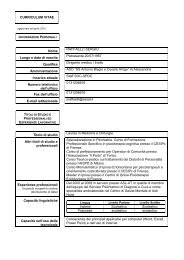
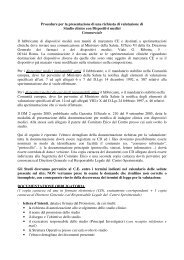

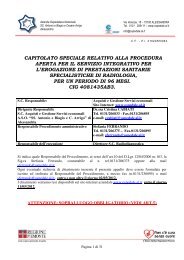
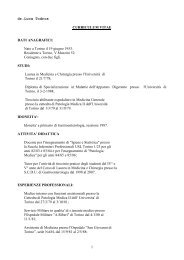
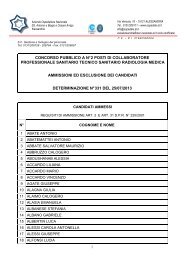

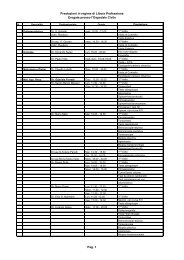


![[torino - 1] lastampa/urc/01 ... 26/10/09 - Azienda ...](https://img.yumpu.com/44058002/1/190x32/torino-1-lastampa-urc-01-26-10-09-azienda-.jpg?quality=85)

